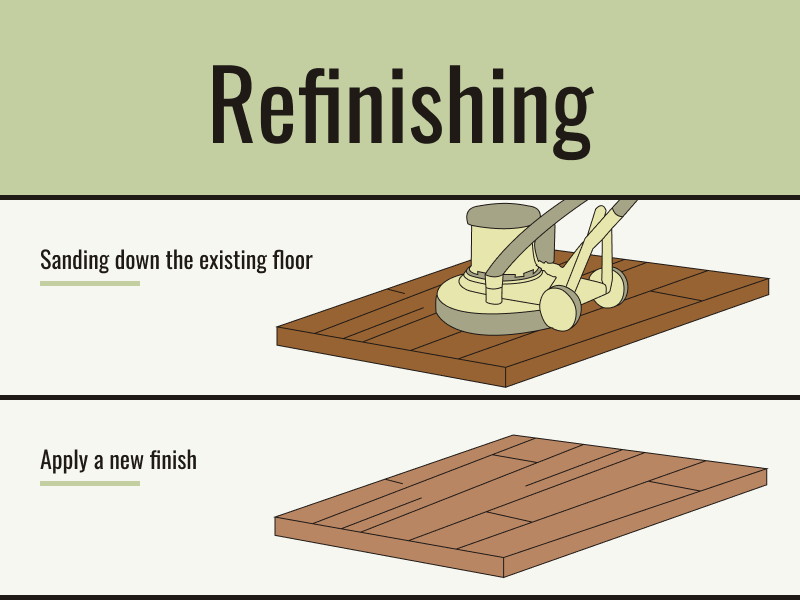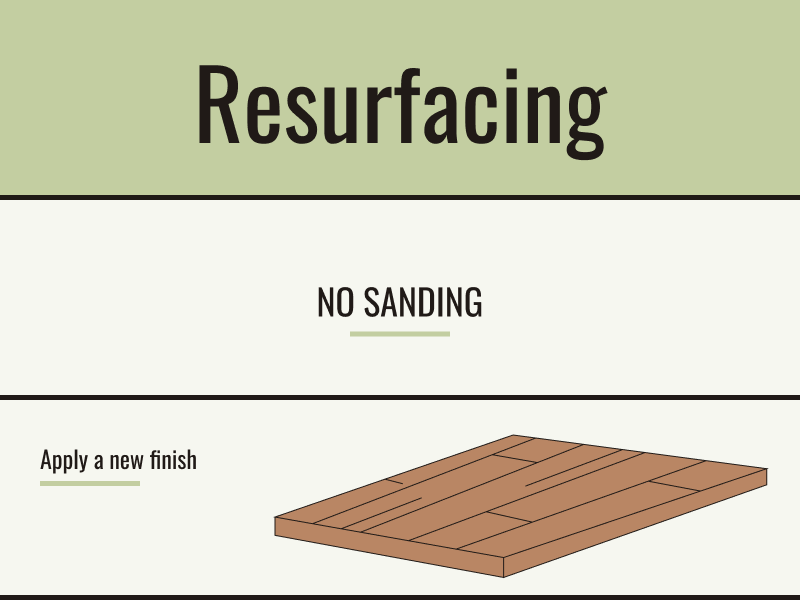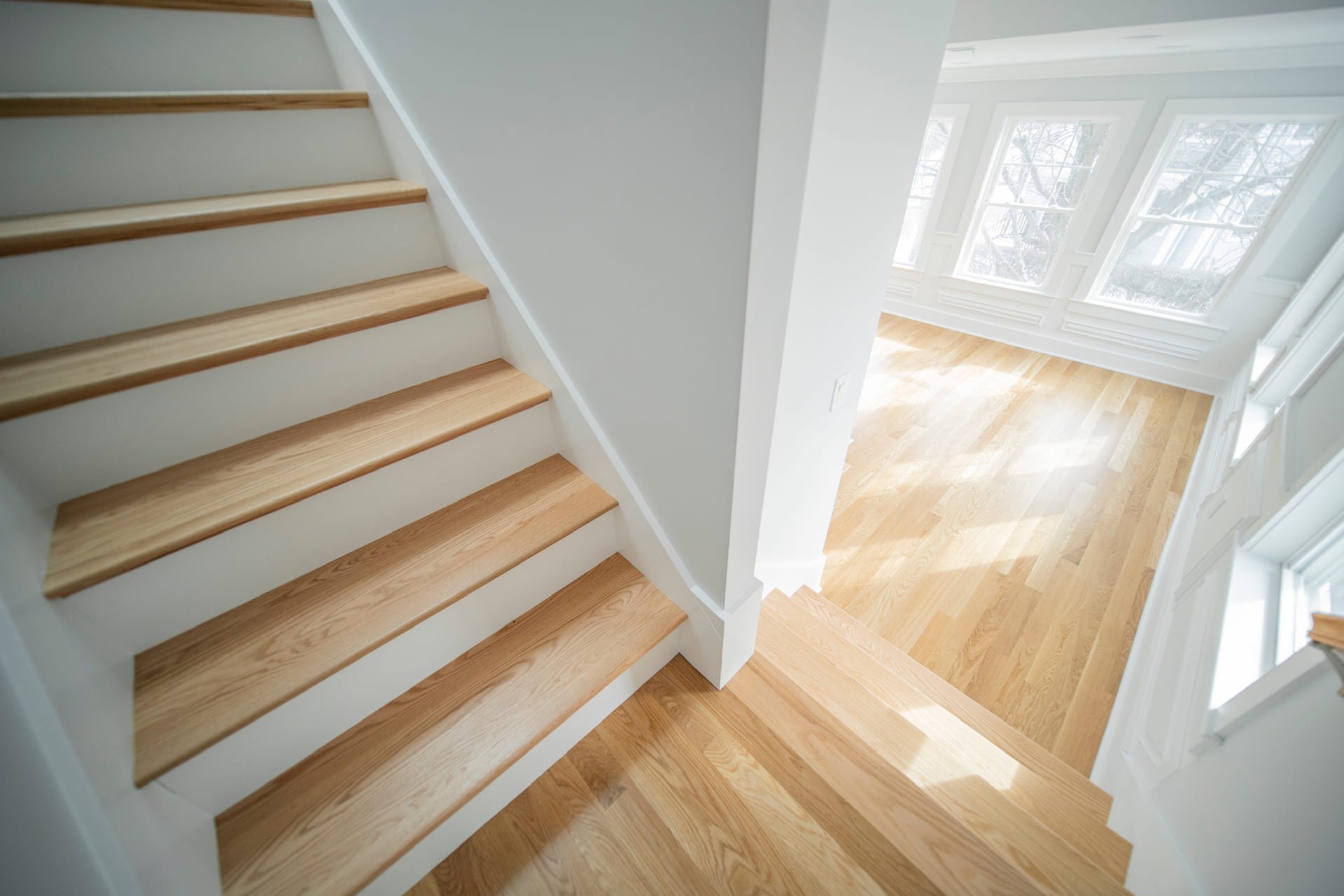Refinishing and resurfacing are two techniques used to restore the appearance and functionality of wood floors. While they may seem similar at first glance, there are some key differences between the two processes that are important to understand before deciding which is the best option for your needs.
🔎 Important Note
In the debate of laminate hardwood floor resurfacing vs refinishing, note that laminate can't be refinished, only resurfaced through cleaning or a new top coat. Major repairs often mean replacing planks, not refinishing.
Refinishing

What is refinishing a hardwood floors?
✨ Refinishing a hardwood floor is like erasing scuffs and scratches to bring it back to its original condition.
Refinishing involves sanding down the existing wood floor to remove the top layer of the finish and expose the raw wood beneath. This allows for any scratches, dents, or other imperfections to be smoothed out and removed. Once the floor has been sanded, a new finish can be applied to protect and enhance the appearance of the wood.
Hardwood Floor Refinishing is typically a more extensive and time-consuming process than resurfacing, as it requires the use of specialized equipment and a certain level of skill to achieve a smooth and even finish.
Resurfacing

What is resurfacing a hardwood floors?
🎨 Resurfacing a hardwood floor is like putting on a new coat on floors to instantly make it look better, without fixing the deeper defects underneath.
Resurfacing involves applying a new layer of finish directly over the existing wood floor, without sanding down the surface.
Hardwood Floor Resurfacing is generally quicker and easier than refinishing, as it does not require the use of heavy machinery or specialized equipment. However, it is important to note that resurfacing will not be able to repair any deeper imperfections in the wood, such as scratches or dents, and may not be as durable as a refinishing job. But if you're looking for cheaper way to restore hardwood floors without sanding, then resurfacing is the way to go.
🔎 Important Note
Resurfacing ≠ Replacement. Resurfacing or recoating of hardwood floors is not a full replacement of the hardwood floor. A full replacement would be much more expensive!
So which option is best for you? If your wood floor is in good condition, with only minor scratches or wear, hardwood resurfacing may be a suitable option. However, if your floor has more significant damage or imperfections, or if you are looking to change the color or finish of your floor, hardwood refinishing may be a better choice.
Points to consider when deciding between refinishing and resurfacing wood floors:

→ Cost

Refinishing is generally more expensive than hardwood resurfacing, due to the use of specialized equipment and the time and labor required to complete the process. However, refinishing may be a more cost-effective option in the long run, as it can extend the life of your wood floor and may be less prone to wear and damage compared to a resurfaced floor.
Moreover, according to Homeadvisor, refinishing hardwood floors costs between $1,099 and $2,660, averaging at $1,879. In contrast, hardwood floor repair, akin to resurfacing or recoating, averages $1,024, with costs typically ranging from $478 to $1,636. This initial cost difference highlights refinishing's higher upfront investment. Yet, considering refinishing's long-term benefits of extended floor life and resilience against wear, the higher expense may justify itself over time.
Sources: How Much Does It Cost To Refinish Hardwood Floors?; How Much Does Hardwood Floor Repair Cost?
→ Durability

As mentioned earlier, refinishing typically results in a more durable finish than resurfacing. This is because the sanding process removes the top layer of the wood, allowing the new finish to bond more effectively with the wood. Hardwood resurfacing, on the other hand, simply adds a new layer of finish on top of the existing surface, which may not be as durable.
→ Aesthetics

Hardwood refinishing allows for more flexibility in terms of the appearance of your wood floor. By sanding down the surface, you can choose to apply a different color or finish to your floor, giving you the opportunity to completely transform the look of your space. With resurfacing, you are limited to the appearance of the existing floor, as the new layer of finish will not be able to hide any underlying imperfections or change the color of the wood.
→ Level of Disruption

Both refinishing and resurfacing can be disruptive processes, as they involve sanding and applying finishes to your wood floor. However, refinishing is typically more disruptive, as it requires the use of heavy machinery and may take longer to complete. Resurfacing is generally a quicker and less disruptive process, as it does not require sanding down the surface of the wood.
Choosing Between Hardwood Floor Resurfacing and Refinishing
Refinishing Pros and Cons
🟢 Pros:
- Removes imperfections.
- Enhances appearance and protection
- Allows color/finish changes.
- More durable finish.
🔴 Cons:
- More expensive.
- Time-consuming.
- Disruptive.
Resurfacing Pros and Cons
🟢 Pros:
- Quicker and easier.
- Less disruptive.
🔴 Cons:
- Can't fix deep imperfections.
- Less durable.
- Limited aesthetic changes.
Ultimately, the decision between refinishing and resurfacing wood floors will depend on the condition of your floor, your budget, and your aesthetic and durability goals. It is important to carefully consider all of these factors before making a decision and to consult with a professional flooring contractor if you are unsure which option is best for your needs.



